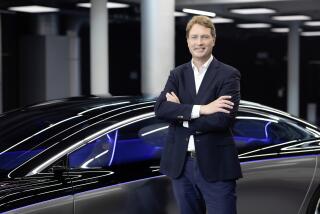The Ultimate Gamble
DETROIT — At first glance, things have never looked better for BMW.
Bayerische Motoren Werke has quadrupled its U.S. sales in the last 10 years, zooming from the No. 5 luxury nameplate in 1995 to No. 2 last year.
The company is preparing some bold moves, including the planning of a small BMW 1-series; reintroduction of the sporty two-door 6-series and the storied Mini brand; and production of a luxury limousine for Rolls Royce, the marque it takes over Jan. 1.
BMW also is very profitable, earning $1.4 billion in the first half of 2001, about as much as General Motors Corp. and Volkswagen, the powerhouse auto makers of the U.S. and Europe, put together. And nobody’s talking about BMW being acquired or forced to partner up in a strategic alliance that has enveloped the other major auto makers except Honda Motor Co.
But BMW also is taking its biggest risk ever with a radical redesign, inside and out, of its flagship 7-series.
The new 7, with prices starting at about $63,000, has an exaggerated lip that curves around the top of the trunk, which many automotive critics find unharmonious at best.
And the jury is still out on iDrive, the revolutionary--but maddening to some--system that lets drivers select and set all controls from climate to audio to navigation with a single, mouse-like knob on the center console.
BMW needs to score well with the 7-series in the U.S., where more 7s are sold than in any other market, even Germany. California is particularly crucial to BMW’s success as it snaps up 22% of BMW sales in the U.S., and nearly one of four 7-series cars is sold in the state--70% of them in Southern California.
“BMW tends to go for MAYA--most advanced, yet acceptable--and the new 7-series pushes the limit of acceptability,” said Rudi Volti, a sociology professor at Pitzer College in Claremont who teaches a “Cars and Culture” course. “The lip gives extra trunk space, but not a lot of 7 owners are in the light-hauling industry.”
The flagship of the BMW line, the 7-series always has highlighted the newest technology such as anti-lock brakes in the 1970s, and traction and stability control. As the top-of-the-line BMW, it bumps heads with the Mercedes S-class and Audi A8 and S8.
BMW has demographics, customer loyalty and a brand aura that any car maker would “sandpaper their eyeballs for,” said Detroit-based auto analyst Jim Hall.
“In our brand consideration study, BMW is just walking on water,” said Hall’s boss, George Peterson, president of AutoPacific consulting firm in Tustin. “It’s a highly aspirational brand for young people. Twenty years ago the 3-series was the ultimate vehicle. The 1-series could be the same for the twentysomethings today.”
With the 1-series, BMW says, it’s going smaller but not downscale, an obvious reference to Mercedes-Benz and its $25,000 C230 hatchback, which some critics say lacks the appointments and feel worthy of a Mercedes.
There also will be a reborn 6-series coupe, originally sold in this country from 1977 to 1989. A two-door that seats four adults, the resurrected 6-series will return to the market in 2004, the same year the 1-series is to arrive.
What BMW calls the “X-family” of SUVs also is expanding with the entry-level, smaller Austrian-built X3, to come on the market next year. The Mini goes on sale in the U.S. this month.
In 1980 only four BMW models were on sale in the U.S.: the 320i, the 528i, the 633Csi and the 733i. (Today about 30 models are in the lineup.) For buyers back then who were aware of BMW--and plenty weren’t--it was seen as a rival to Mercedes: a high-end German luxury brand with solid engineering and reliable quality.
In AutoPacific’s recent brand consideration studies, BMW has outpaced Mercedes among car buyers shopping in that range. BMW’s image has grown so strong that it took a page from Lexus’ handbook and last month launched an aggressive ad campaign for certified pre-owned BMWs.
*
Takeover Rumors
BMW’s strong financials also have enabled the company to fend off potential takeovers, friendly or hostile.
There have been persistent rumors of offers by virtually every large auto maker to purchase, or buy into, BMW. The more credible scenarios have GM or Ford Motor Co. buying a percentage of the company, but that would require winning over the secretive Quandt family that controls about 48% of BMW stock.
Ford would be able to add BMW to the stable of luxury brands in its Premier Automotive Group--Lincoln, Jaguar, Volvo, Land Rover and Aston Martin.
GM would have even more to gain: a globally credible premium brand with a strong international image, something that neither of GM’s premium brands, Cadillac and Saab, can claim.
But the Quandts and BMW executives brush aside such heretical suggestions.
“BMW is big enough, and BMW is strong enough. Why should we merge?” asked Chief Executive Joachim Milberg in an interview with The Times in January at the North American International Auto Show in Detroit. “For market reasons, for technology reasons, for product reasons? No. We have our technology, we are in a good position worldwide and we have a great product portfolio, so there is no reason for BMW for a merger.”
Despite the company’s health, there are complaints about BMWs. For years it was known as a company of “Eine Wurst, drei Groesse” (one sausage, three sizes) for the unimaginative similarity of the 3-, 5- and 7-series.
But now the very design of BMW’s flagship has become a hotly debated issue, with the new 7’s look roasted in the enthusiast press and driving reviews. The expert consensus is that it’s an acquired taste.
“The styling’s risky, but I think over time people will accept it,” Peterson said. “When I first saw it, it was like, ugggh. But I’m starting to warm up to it.”
Rebecca Lindland, senior auto analyst with forecasting group DRI-WEFA, is charitable as well. “I like it. It’s definitely different, and not always completely appealing to the eye,” she said. “But it’s unmistakable from the back and the side--it’s clearly the new 7-series.”
BMW is quick to defend the styling and says it allows the car to be slightly higher without making it longer. Besides, BMW executives say, it was a necessary “revolutionary” step after the “evolutionary” last design change for the 7-series in 1994.
With the all-new 1-series and 6-series coming, and the extension of the X-family of SUVs, “the product portfolio will be much broader in the future, so we needed, let’s say, a new ‘shape language’ for our cars,” Milberg said.
The skewering the 7-series is receiving in the media is getting old to Chris Bangle, the American who is BMW’s chief designer at its Munich, Germany, headquarters. He dismisses the potshots at his design as fashionable pooh-poohing of the car before pundits had a chance to drive it
“Significance requires controversy, otherwise we’re not moving forward,” the Wisconsin native said.
“If we do things that people easily accept, then the only part of the mystique lies in the unavailability of it. If we’re doing a car we want to make available, like the 7-series, that can’t be our only card to play. We have to make something which makes a car fascinating and interesting for the longer term,” Bangle said. “We have to grow with the car; otherwise you get bored with it.”
For probably the first time, however, it’s more than a BMW’s looks or handling that will polarize potential customers. The technology itself is so daunting that it could turn people away.
Some BMW owners and aspirants, among the most aggressive early-adapters in the industry, will eat it up. “I think that people who drive the 7-series want to be on the edge,” DRI-WEFA’s Lindland said. “They want the early-edge technology, and that’s what BMW has given them.”
*
Youthful Appeal
The risk is that the vaunted technology could overshadow the 7’s driving performance. To start the car, for instance, drivers first must insert an optical key, press the brake, then push a button on the dashboard that engages the motor--a process that will have to be explained countless times to parking valets.
Most owners probably will learn the dozen iDrive functions they need to know to adjust the air conditioning, set the clock and change the radio stations--leaving the remaining 690 operations unexplored.
“I haven’t spoken to anyone who doesn’t work for BMW who can use iDrive,” AutoPacific’s Peterson said. “The jury’s out, and iDrive could really hurt them.”
Using the flagship 7-series as a test for such a technological leap is a genuine risk, because the reception of the 7 reflects how BMW is perceived overall.
Though the car has been on the market only since January, some analysts in Detroit already are talking about “Death by iDrive.”
“The iDrive might appeal to younger-generation drivers who enjoy joysticks and other gadgets, but the owner profile of the 7-series is more pre-electronic,” said Volti, the Pitzer professor.
The gadgety 7-series actually might turn off buyers and chase them to another brand in the constantly shifting American market.
“Cars have gotten pretty good, and the difference between a $25,000 and a $70,000 car is not that great,” Volti said.





